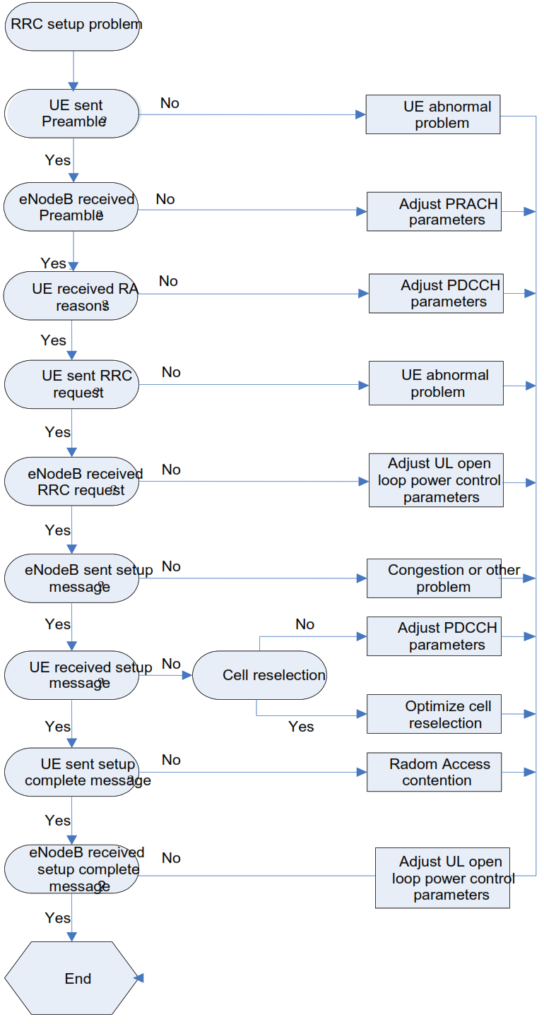RRC (Radio Resource Control) connection establishment is a signaling process in LTE networks, enabling UEs (User Equipment) to communicate with the network. Failures in RRC connection establishment can significantly degrade user experience and network performance. This article explain the causes of RRC connection establishment failures and provides a technical approach to troubleshooting these issues.
RRC Connection Establishment Failures
RRC connection establishment failures can be effectively analyzed using UE signaling procedures and signaling trace tools any. The process involves identifying the failure points and understanding the underlying causes.
Below picture shows for Troubleshooting an RRC Connection Establishment
Problem.

Causes of RRC Connection Establishment Failures.
RRC connection establishment failures can be happened due to several reasons:
1. Call Signaling Interruption:
Occurs when the call originates from a cell with weak signals or poor coverage.
2. Uplink RACH Problems:
Issues with the Random Access Channel (RACH) can prevent the UE from establishing a connection.
3. Paging Failures During TAU:
Tracking Area Update (TAU) related issues can lead to connection failures.
4. Cell Reselection Parameter Misconfiguration:
Incorrect parameters can cause the UE to not select the best cell for call origination.
5. RS Power and Power Allocation Parameter Misconfiguration:
Improper settings can affect the transmission and reception quality.
6. Traffic Congestion:
High network load can lead to connection failures.
7. Equipment Faults:
Hardware issues in the network infrastructure.
It is highest possibility RRC connection establishment failure may occur due to Weak signals in the downlink, Uplink RACH problem, Cell reselection parameter misconfiguration
and Equipment fault.
Common Causes and Solutions.
Weak Downlink Signals.
- Cause:
- Poor coverage, leading to low RSRP (Reference Signal Received Power).
- Solutions:
- Perform RF optimization to troubleshoot undershooting or overshooting.
- Enhance coverage by installing additional sites or optimizing the antenna and feeder systems.
- Adjust RS power to improve signal strength.
Uplink RACH Problems.
- Cause:
- Insufficient power ramping level, low UE output power, high VWSR (Variance of Weighted Sum of Resources), or improper cell radius configuration.
- Solutions:
Cell Reselection Parameter Misconfiguration.
- Cause:
- Misconfigured cell reselection parameters causing the UE to not select the optimal cell.
- Solutions:
- Optimize cell reselection parameters to ensure the UE can reselect the preferable cell for call origination.
- Modify parameters to speed up the cell selection and reselection process.
Equipment Faults.
- Cause:
- Hardware faults leading to abnormal RRC processes.
- Solutions:
- Regularly check and address hardware faults and alarms.
- Ensure all network equipment is functioning correctly and within specifications.
Specific Issues and Their Solutions.
Failing to Receive the RRC Connection Request Message.
- Potential Causes:
- Low RSRP indicating coverage problems.
- RACH problems if RSRP is not too low.
- Solutions:
- Enhance coverage and adjust power allocation parameters.
- Ensure sufficient power ramping levels and appropriate UE output power.
- Address eNodeB faults and ensure proper cell radius configuration.
Failing to Receive the RRC Connection Setup Message.
- Potential Causes:
- Poor coverage or inappropriate cell selection/reselection parameters.
- Solutions:
- Enhance coverage if possible by adding sites or optimizing the antenna system.
- Adjust RS power and corresponding power allocation parameters.
- Modify cell selection and reselection parameters to expedite the process.
Receiving the RRC Connection Reject Message.
- Potential Causes:
- Congestion or unspecified issues.
- Solutions:
- For congestion, monitor and manage network usage.
- For unspecified issues, analyze log information to identify and resolve the underlying cause.
Failing to Deliver the RRC Connection Setup Complete Message.
- Potential Causes:
- Possible handset fault if downlink signals are normal.
- Solutions:
- Investigate and address potential handset faults.
- Ensure the UE’s transmit power is appropriately controlled.
Conclusion.
RRC connection establishment failures in LTE networks can happen from various causes, ranging from coverage issues to parameter misconfigurations and hardware faults. By systematically identifying and troubleshooting these causes, network operators can significantly enhance connection success rates, thereby improving overall network performance and user satisfaction. Regular monitoring, optimization, and proactive troubleshooting are essential to maintaining a robust and reliable LTE network.